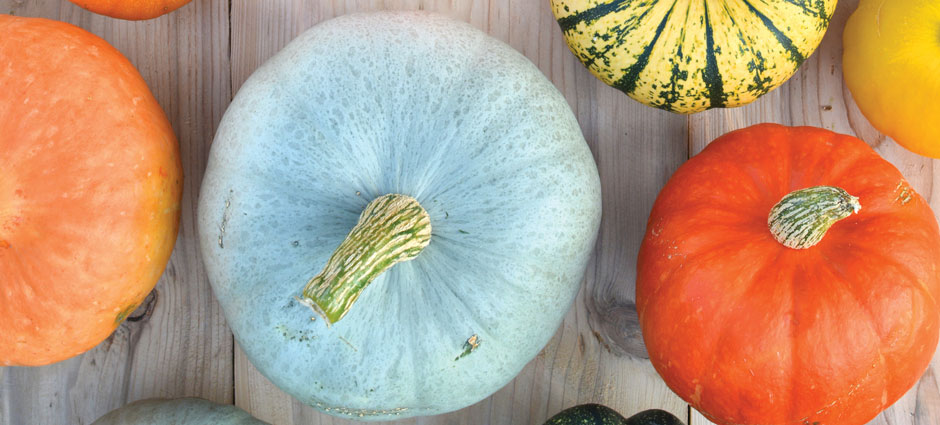The term “squash” derives from the Native American Narragansett word askutasquash, which translates as “eaten raw or uncooked.” Squash is one of the oldest known crops, 10,000 years old according to some estimates. All forms of squash arose in the Americas, primarily in the areas that are now Mexico and Central America.
George Washington and Thomas Jefferson were enthusiastic squash growers. In the 19th century, merchant seamen returned from other parts of the Americas with many new varieties. This resulted in the various colors, shapes and sizes that are available today.
Fall vs. Winter Squashes
Fall squash refers to varieties harvested during the fall. This group includes zucchinis, crooknecks, pattypans (scalloped types) and tender spherical squashes.
Winter squashes are more diverse and includes all varieties harvested at the end of fall when they are fully mature. These include: acorn, butternut, delicata, spaghetti, all gourds and a host of pumpkins.
Winter squash is a warm-weather crop, but it gets its name because it can be stored through the winter. Unlike its fall counterparts, winter squash is harvested at a mature age, which makes the skin hard and inedible. The skin, however, is protective and increases its storage life. Winter squash can be stored for three months or longer.
Some Popular Varieties
- SPAGHETTI: The flesh separates into strands when roasted, so it can be served like pasta. The larger the squash, the thicker the strands and the more flavorful the taste. Contains small amounts of vitamin C, vitamin B6 and manganese. Has a bright-yellow skin.
- DELICATA: Also called sweet potato squash, this variety is thin-skinned, so you can eat the peel after roasting. Has a mild, sweet flavor. Good source of vitamins A and C. Light-yellow color with orange and green stripes.
- ACORN: One of the most widely available. Baking is the best way to bring out its flavors. No need to peel; the skin is edible. Good source of potassium, manganese and vitamin C. Dark-green skin, with one yellow or orange spot where it was resting on the ground.
- BUTTERNUT: This is a real crowd-pleaser: very flavorful and sweet. Easily skinned with a vegetable peeler, making it easy to cut and prepare. Baking enhances its sweet, nutty flavor. Excellent source of vitamins A and C. Skin is light brown, but the inside is bright orange.
- KABOCHA: This Japanese squash, shaped like a small pumpkin, becomes extra creamy when cooked, so it makes a good puree for soup. Exceptional sweet flavor. Despite the rind’s rough texture, it can be eaten when cooked. Great source of vitamin A. Dark-green with pale-green speckles.
Ways to Cook
- Winter squashes can be roasted, braised, steamed, boiled, microwaved or simmered.
- Substitute any variety of cooked, mashed squash for canned pumpkin in soup, pie, cookie or bread recipes.
- Mash cooked squash with sautéed onion or garlic and herbs for a savory side dish.
- Bake squash halves with a savory vegetable and breadcrumb filling.
- Use pureed squash as a side dish, or add to soups, sauces or stews for thickening, color and flavor.
Fall For Squash
With their stripes and hues, from pale yellow to green to the brightest of oranges, fall and winter squash infuse dishes with a healthy aesthetic.
Optimum Wellness is excited to partner with Johnson & Wales University. Chef Jorge de la Torre, Dean of Culinary Education at JWU’s School of Culinary Arts, developed these recipes. Known as a recognized leader in culinary education, JWU is changing the way the world eats. For info, visit jwu.edu/denver.
Try these recipes from Live Naturally featuring gourds:

